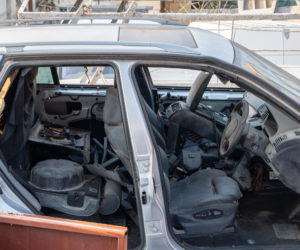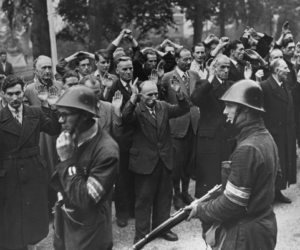Republican presidential nominee Donald Trump has been harping on a “pay for protection” policy as a condition for coming to the defense of our NATO allies. He has questioned the utility of NATO, and continues to praise Russia and its leader — even asking Russian intelligence services to hack into a former Secretary of State’s files, “essentially urging a foreign adversary to conduct cyber espionage.”
Trump, in his admiration and praise for Putin, has even gone as far as appearing “to suggest he’d recognize Russia’s annexation of the Ukrainian territory in 2014.”
Such statements prove that Trump doesn’t know beans about the free world’s security arrangements. His utterances only serve to undermine our common security arrangement and are not likely to inspire much confidence in the Republican presidential nominee in the minds of our European allies while at the same time are “likely to spread much cheer through Russia — already buoyant about the prospect of a Trump victory in November.”
These uniformed and irresponsible statements come at a time when Putin “is pushing the boundaries for what his country’s foreign policy is going to be about for the next decade,” according to Elissa Slotkin, acting assistant secretary of defense for international security affairs, at the recent Aspen Security Forum in Colorado.
Slotkin believes that Putin is pushing wherever he thinks there is weakness” to see how far he can get.”
She thinks Putin is already doing that in countries bordering Russia, such as the Baltics, Ukraine, Moldova, and Romania.
The Baltic States include Estonia, one of the countries most threatened by Russia and a country that already is meeting its commitment for contributing 2% percent of its GDP on defense.
Citing that Russia is pushing boundaries, Slotkin points to Russia’s significant modernization of its military and its recent aggressive postures in the Arctic, the Baltic Sea, the Black Sea and other areas in the region, and that Russia is developing capabilities in cyber and space and improving its maritime and air capabilities.
Slotkin adds that the Russians are attempting to divide Europe and that “Part of dividing Europe is dividing the views of America and our democracy and whether that is a model to pursue.”
Mr. Trump, with his totally uniformed and dangerous comments on NATO and our European alliance and commitments may be helping Russia in this.
Fortunately, at least for another five months, the present commander-in-chief will continue to unconditionally meet our obligations to the common security and defense of Europe under Article 5.
At the recent NATO Summit in Warsaw, Poland, President Obama, referring to the multitude of security and terrorism challenges we face, said “I want to take this opportunity to state clearly what will never change — and that is the unwavering commitment of the United States to the security and defense of Europe, to our transatlantic relationship, to our commitment to our common defense.”
During that meeting, NATO nations agreed to move forward with the most significant reinforcement of NATO’s collective defense any time since the Cold War.
As part of such reinforcement, the United States will be the lead nation in Poland, deploying a battalion of U.S. soldiers to that country. An additional U.S. Armored Brigade will rotate through Europe, including an additional 4,000 U.S. troops.
While President Obama thanked those nations that pay their full share of 2 percent of their GDP for collective defense, and while the members had a “candid conversation” about those allies who are not hitting the 2 percent mark, there were no Trump-like threats not to come to the defense of those countries who presently have difficulty in coming up with the money.
The photos below are images of our troops in various military operations and exercises in Europe.
Soldiers conduct maintenance checks for an AH-64D Apache Longbow attack helicopter during aerial gunnery training at the 7th Army Training Command’s Grafenwoehr Training Area, Germany, Aug. 3, 2016. Army photo by Christoph Koppers

An F-16 Fighting Falcon pilot, from the Colorado Air National Guard’s 140th Fighter Wing at Buckley Air Force Base, Colo., taxis down the flightline before takeoff during exercise Slovak Warthog, July 27, 2016, at Sliac Air Base, Slovakia. (U.S. Air National Guard photo/Staff Sgt. William Hopper)
An Abrams tank fires a round during the multinational exercise Saber Guardian 16 near Cincu, Romania, Aug. 6, 2016. Approximately 2800 military personnel from 10 nations are taking part in Saber Guardian. Army photo by Staff Sgt. Corinna Baltos

U.S. Marines assigned to Special Purpose Marine Air-Ground Task Force-Crisis Response-Africa board an MV-22 Osprey to kick off Exercise Orion 16 at military training area Tancos, Portugal, June 22, 2016. Marine Corps photo by Staff Sgt. Tia Nag
A sailor conducts a live-fire exercise aboard the guided-missile destroyer USS Ross as part of Exercise Sea Breeze 2016 in the Black Sea, July 28, 2016. The maritime exercise aims to improve maritime safety, security and stability in the Black Sea. Navy photo by Petty Officer 1st Class Theron J. Godbold
A C-130H Hercules, from the 179th Airlift Wing at Mansfield Lahm Air National Guard Base, Ohio, takes off to perform an airdrop during exercise Slovak Warthog, July 27, 2016, at Sliac Air Base, Slovakia. Members of the U.S. and Slovak armed forces joined together for the exercise to demonstrate joint operations with a variety of aircraft. (U.S. Air National Guard photo/Staff Sgt. William Hopper)
Soldiers plot grid coordinates for targets during Exercise Flaming Thunder in Pabrade, Lithuania, Aug. 4, 2016. Flaming Thunder is a two-week exercise that aims to enhance interoperability among NATO fire-support units. Army photo by Pfc. James Dutkavich
A C-17 Globemaster aircraft performs a flyby maneuver over an F-16 Fighting Falcon aircraft being refueled by a Hungarian tanker at Papa Air Base, Hungary, July 19, 2016. Air National Guard photo by Senior Master Sgt. John Rohrer
Army National Guard soldiers take up defensive positions during Exercise Saber Guardian 16 at the Romanian Land Force Combat Training Center in Cincu, Romania, July 28, 2016. Army photo by Staff Sgt. Corinna Baltos
Our Navy presence in the Mediterranean also helps with the rescue of migrants attempting the dangerous crossing to safety and security (below).
A team from the guided-missile destroyer USS Carney approaches a migrant vessel in the Mediterranean Ocean, July 29, 2016. The Carney, which provided food and water to the migrants before coordinating with a nearby merchant vessel to take them to safety, is patrolling in the U.S. 6th Fleet area of operations. Navy photo by ISC Wesley R. Dickey
Photos: DoD
Lead photo: Courtesy NATO: NATO and Allied flags flying at half-mast at NATO Headquarters on Saturday (14 November 2015) to pay tribute to the victims of the terrorist attacks in Paris and in solidarity with the people of France.

























